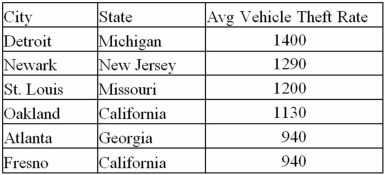The following data represents motor vehicle theft rates per 100,000 people for the cities of Detroit,Michigan,Newark,New Jersey,St.Louis,Missouri,Oakland,California,Atlanta,Georgia,and Fresno,California.These six cities had the highest per-capita motor vehicle theft rates in the nation in 2010.  a.What is the mean and median per-capita theft rates of the above cities?
a.What is the mean and median per-capita theft rates of the above cities?
B)Given the standard deviation of the per-capita crime rate in Detroit is 200 thefts per 100,000 use the empirical rule to calculate the probability Detroit has over 1800 thefts per 100,000 next year?
Definitions:
Efficient Level
The point at which a system or operation is performing at its maximum potential without wasting resources.
Megawatts
A unit of power measurement equal to one million watts, commonly used to express the output of large power plants or the amount of electrical energy used by large entities.
Consumer Surplus
The difference between the total amount consumers are willing and able to pay for a good or service and the total amount they actually do pay.
Producer Surplus
The difference between what producers are willing and able to sell a product for and the actual price they receive, indicating the benefit to producers.
Q5: For which of the following population parameters
Q6: The ordinal scale of data measurement is
Q11: George Dantzig is important in the history
Q38: Let P<sub>ij</sub> = the production of product
Q43: Inputs to a quantitative model<br>A)are a trivial
Q52: Which of the following is NOT true
Q57: Restaurants in London,Paris,and New York want diners
Q82: Calculate the interquartile range from the following
Q102: Which of the following statements is most
Q114: Which of the following is correct?<br>A)A continuous